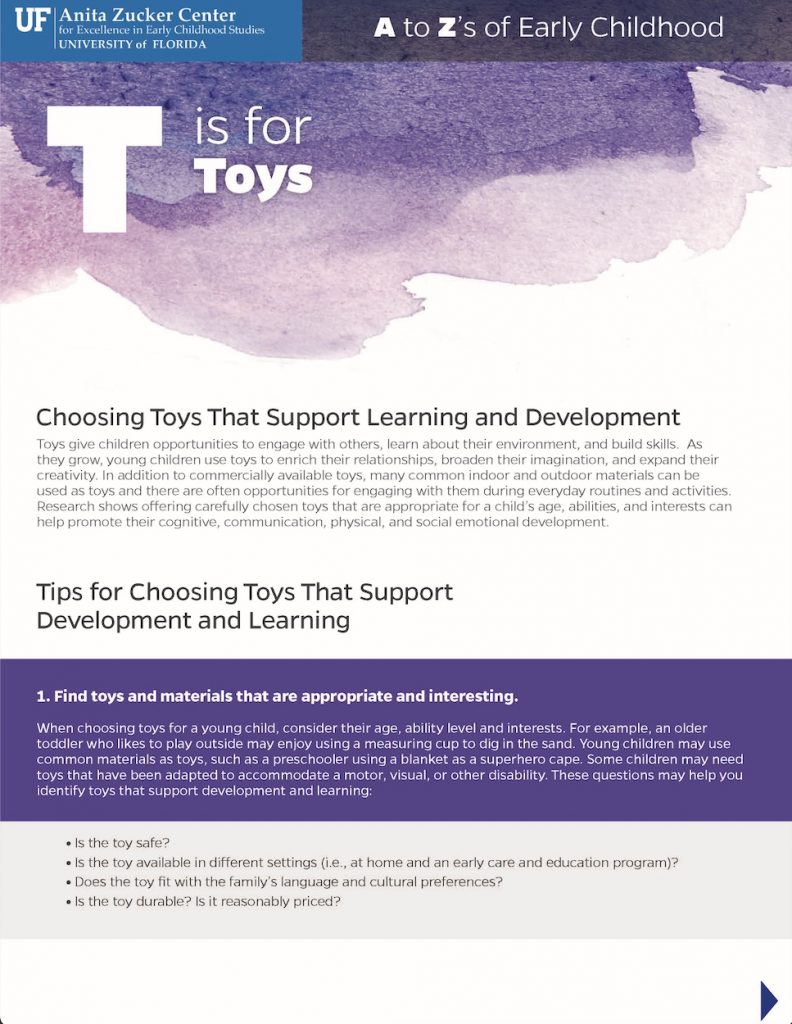A to Z’s of Early Childhood
The Science of Child Development and Learning
T is for Toys
Choosing Toys That Support Young Children’s Development and Learning
Toys foster children’s engagement with others, help them learn about their environment, and support skill development. As they grow, young children use toys to enrich their relationships, broaden their imagination, and expand their creativity.2,3 In addition to commercially available toys, children use many common indoor and outdoor materials as toys and there are often opportunities for engaging with them during everyday routines and activities. Offering carefully chosen toys that are appropriate for a child’s age, abilities, and interests can help promote their cognitive, communication, physical, and social emotional development.1
Tips for Choosing Toys That Support Development and Learning:
1. Find toys and materials that are appropriate and interesting.
When choosing toys for a young child, consider their age, ability level and interests. For example, an older toddler who likes to play outside may enjoy using a measuring cup to dig in the sand. Young children may use common materials as toys, such as a preschooler using a blanket as a superhero cape. Some children may need toys that have been adapted to accommodate a motor, visual, or other disability. For example, providing toys that make noise can help an infant with low vision learn to reach and grasp. These questions may help you identify toys that support development and learning:
- Is the toy safe?
- Is the toy available in different settings (i.e., at home and an early care and education program)?
- Does the toy fit with the family’s language and cultural preferences?
- Is the toy durable? Is it reasonably priced?
2. Understand which toys can be used to build developmental skills during everyday routines and activities.
Young children learn more when they interact with toys and materials through repetition and routines. Caregivers can observe their child’s current skills and help expand those skills by encouraging their child to engage with toys or materials that support their development and learning throughout the day. For example, during a routine morning walk, a toddler may use a stick to draw lines in the sand, which helps them develop fine motor skills. For all children, repeated learning opportunities within everyday routines help build connections in the brain that advance development and learning.
3. Identify how each toy supports the child’s development and learning.
Other Resources
- Developmentally Appropriate Toys
This resource from Mount Sinai provides information about toys that support children’s development in a variety of ways. - Good Toys for Young Children by Age and Stage
Learn about age-appropriate toys, from birth to kindergarten, from the National Association for the Education of Young Children (NAEYC). - Why This Toy?
This NAEYC resource offers guidance to parents and caregivers on how to select toys for children. - What the Research Says: Impact of Specific Toys on Play
In this Q&A, a toy researcher explains the many effects toys have on children. - Selecting Gifts for the Young Children in Your Life
Visit this website for fun, useful tips about giving gifts to children. - Top 10 No-Cost Toys for Infants, Toddlers, and Preschoolers
Learn about free ways to play with toys in this resource from NAEYC. - Tips for Choosing Toys for Toddlers
This Zero to Three article guides parents and caregivers through selecting toys that help their toddlers’ growth and development. - Choosing Toys and Resources of Children with Low Vision
This resource from the American Academy of Ophthalmology provides guidance for parents and caregivers on selecting toys for children with low vision at various developmental stages.
Articles By Center Members and Collaborators
- Snyder, P. A., & Hemmeter, M. L. (Eds.). (2018). Instruction: Effective strategies to support engagement, learning, and outcomes: DEC Recommended Practices Monograph Series (No. 4). Division for Early Childhood.
References
- Buysse, V. (1994). Toy play in infancy and early childhood: Normal development and special considerations for children with disabilities. In D.B. Bailey (Ed.), Research synthesis on early intervention practices. Office of Special Education and Rehabilitative Services.
- Glassy, D., Romano, J., & Committee on Early Childhood, Adoption, and Dependent Care. (2003). Selecting appropriate toys for young children: The pediatrician’s role. Pediatrics, 111(4), 911-913. https://doi.org/10.1542/peds.111.4.911
- Healey, A., Mendelsohn, A., & Council on Early Childhood. American Academy of Pediatrics. (2019). Selecting appropriate toys for young children in the digital era. Pediatrics, 143(1), e20183348. https://doi.org/10.1542/peds.2018-3348
- Mount Sinai Parenting Center. (n.d.). Safe, fun, and developmentally appropriate toys: Toddlers learn best through play. https://parenting.mountsinai.org/parent-guide/developmentally-appropriate-toys
- National Association for the Education of Young Children (n.d.). What the research says: Impact of specific toys on play [Interview]. https://www.naeyc.org/resources/topics/play/specific-toys-play
Receive Additional Support
The complete 3R’s of Early Learning downloadable video recordings (including the A to Z’s of Early Childhood) for use in the field of childhood development to facilitate learning are available for purchase.
If you would like to purchase these resources or speak with a member of our team for help in providing professional development, please complete this contact form.

